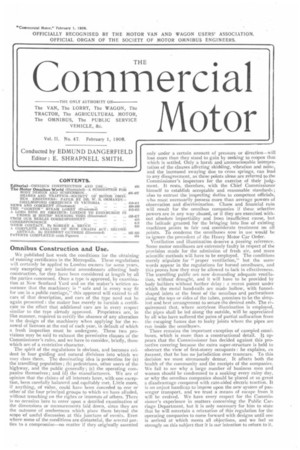Omnibus Construction and Use.
Page 1

If you've noticed an error in this article please click here to report it so we can fix it.
We published last week the conditions for the obtaining of running certificates in the Metropolis. These regulations will certainly be applied to London owners for some years, only excepting any incidental amendments affecting body construction, for they have been considered at length by all the parties concerned. Once a type is approved, by examination at New Scotland Yard and on the maker's written assurance that the machinery is " safe and in every way fit for use in a public carriage," this approval will extend to all cars of that description, and cars of the type need not be again presented : the maker has merely to furnish a certificate to the effect that additional cars are in every respect similar to the type already approved. Proprietors are, in like manner, required to certify the absence of any alteration in the design of the machinery when applying for the renewal of licenses at the end of each year, in default of which a fresh inspection must be undergone. These two provisions may be said to exhaust the permissive clauses of the Commissioner's rules, and we have to consider, briefly, those which are of a restrictive character.
The spirit of the regulations is obvious, and becomes evident in four guiding and natural divisions into which we may class them. The dominating idea is protection for (a) the travelling population ; (b) pedestrians, other users of the highway, and the public generally ; (c) the operating companies themselves; and (d) the manufacturers. We are of opinion that the claims of all interests have, with one exception, been carefully balanced and equitably met. Little more, if anything, of value, could have been conceded to one or other of the four principal groups to which we have alluded, without trenching on the rights or interests of others. There is no occasion here to enter upon a detailed examination of the dimensions or measurements laid down, since they are the outcome of conferences which place them beyond the scope of useful discussion at this juncture of events. Even where some of the conditions are distasteful, the several parties to a compromise—no matter if they originally assented Ionly under a certain amount of pressure or direction—will lose more than they stand to gain by seeking to reopen that which is settled. Only a harsh and unconscionable interpretation of the clauses affecting skidding, vibration and noise, and the increased swaying due to cross springs, can lead to any disagreement, as these points alone are referred to the
Commissioner's inspectors for the exercise of their judgment. It rests, therefore, with the Chief Commissioner himself to establish acceptable and reasonable standards ; also to entrust the inspecting duties to competent officials, who must necessarily possess more than average powers of observation and discrimination. Chaos and financial ruin will result for the omnibus companies if these selective powers are in any way abused, or if they are exercised without absolute impartiality and front insufficient cause, but the latitude granted for the bringing into line of existing machines points to fair and considerate treatment on all points. To condemn the omnibuses now in use would be to ignore the precedent of the Heavy Motor Car Order. Ventilation and illumination deserve a passing reference. Some motor omnibuses are extremely faulty in respect of the provision made for the admission of fresh air, and more
scientific methods will have to be employed. The conditions merely stipulate for " proper ventilation," but the same
words appear in the regulations for horsed omnibuses, and this proves how they may be allowed to lack in effectiveness. The travelling public are now demanding adequate ventila tion, without draught, and it will have to be provided by body builders without further delay : a recent patent under which the metal hand-rails are made hollow, with funnel shaped inlets at the front of the omnibus and perforations
along the tops or sides of the tubes, promises to be the simplest and best arrangement to secure the desired ends. The re
quirement that, where acetylene illumination is employed, the pipes shall be led along the outside, will be appreciated by all who have suffered the pains of partial suffocation from the escaping fumes due to leaky joints where the pipes are run inside the omnibuses.
There remains the important exception of canopied omnibuses, which is more than a constructional detail. It ap pears that the Commissioner has decided against this pro tective covering because the extra super-structure is held to obstruct the view of first-storey occupants : he explains, eit fiassant, that he has no jurisdiction over tramcars. To this decision we most strenuously demur. It affects both the health of the community and the receipts of the companies.
We fail to see why a large number of business men and women should be condemned to a soaking every rainy day, or why the omnibus companies should be placed at so great a disadvantage compared with rate-aided electric traction. It is an unjust handicap to impose upon the new system of passenget transport, and we trust a means of escape from it will be evolved. We have every respect for the Commis sioner's experience in matters concerning the Public Carriage Department, but it is only necessary for him to state that he will entertain a relaxation of this regulation for the operating companies to come forward with designs until one is arrived at which meets all objections, and we feel so strongly on this subject that it is our intention to return to it.




















